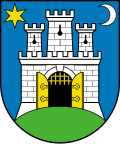This article needs additional citations for verification .(December 2014) |
Akademija likovnih umjetnosti u Zagrebu (ALU) | |
 | |
| Type | Public |
|---|---|
| Established | 1907 |
| Dean | Tomislav Buntak |
| Students | 365 |
| Location | , 45°48′44″N15°57′45″E / 45.8121°N 15.9624°E |
| Website | alu.hr |
 | |
The Academy of Fine Arts Zagreb (Croatian : Akademija likovnih umjetnosti u Zagrebu or ALU) is a Croatian art school based in Zagreb. It is one of the three art academies affiliated with the University of Zagreb, along with the Academy of Dramatic Art (ADU) and the Academy of Music (MUZA).
